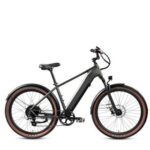Learning to Wheelie A Bike is a challenging yet rewarding skill that can significantly enhance your bike handling and impress your friends. While it might seem daunting at first, with the right technique and plenty of practice, you can master the art of the wheelie. Even seasoned cyclists recognize the wheelie as a difficult maneuver, highlighting the dedication required to perform it well. This guide breaks down the process into manageable steps, offering tips and warnings to help you learn how to wheelie a bike safely and effectively.
Step-by-Step Guide to Wheelieing a Bike
Performing a wheelie involves a series of coordinated movements that require balance, control, and understanding of your bike’s dynamics. Here’s a step-by-step breakdown to get you started:
1. Gear and Seat Setup for Wheelies
Before attempting a wheelie, adjust your seat to a lower position than you would for normal riding. A lower seat provides more room to maneuver and helps lower your center of gravity, which is crucial for maintaining balance when you learn to wheelie a bike. Select a medium or low gear; this will allow you to pedal with enough force to lift the front wheel without excessive speed initially.
2. Starting Position and Momentum
Begin by riding at a slow rolling speed on a flat, open area. Crouch your upper body towards the handlebars, positioning your weight forward. This pre-load is essential for the initial lift. Ensure your cranks are positioned with one at approximately the 11 o’clock position, ready for a powerful pedal stroke.
3. The Pop: Pedal and Pull to Lift the Front Wheel
This is the critical step to initiate the wheelie. As you pedal down with your dominant foot, simultaneously pull up sharply on the handlebars. This synchronized action, combining pedal force and pulling motion, is what lifts the front wheel off the ground. It’s important to practice this coordination to get the front wheel airborne effectively.
4. Balance is Key: Leaning Back and Pedaling
Once the front wheel is up, immediately lean back as if you’re relaxing in a rocking chair. Continue pedaling to maintain momentum and balance. Trust in your rear brake; it’s your primary tool for preventing yourself from tipping too far backward. Extend your arms to help with balance and slide slightly back on your seat, towards the tip, to shift your weight further back.
5. Rear Brake Control: Your Safety Net for Wheelies
Keep a finger lightly positioned on the rear brake lever at all times. Feathering the rear brake—applying it gently and intermittently—is crucial for controlling your wheelie. If you feel yourself leaning too far back, a slight tap on the rear brake will bring the front wheel down and prevent a fall. This brake control is what separates a controlled wheelie from a potential wipeout.
6. Steering and Sideways Balance in a Wheelie
Maintaining balance isn’t just about vertical control; you also need to manage sideways balance. If you feel the bike leaning to one side, subtly counter-steer by turning the handlebars slightly in the opposite direction. You can also use your knees or feet to adjust your center of gravity and maintain a straight line. Correcting sideways balance early is easier than trying to recover once it’s significantly off.
7. Bringing it Down from a Wheelie
To end the wheelie, simply stop pedaling and allow the front wheel to gently descend back to the ground. Ensure your handlebars are straight as the front wheel touches down to maintain control as you transition back to two wheels.
Tips for Mastering the Wheelie
- Practice on a slight incline: Learning to wheelie uphill can make it easier to get the front wheel up initially as gravity assists in lifting the front.
- Ride flat pedals: Flat pedals are generally recommended for learning wheelies as they allow you to easily bail out if you lose balance, unlike clipless pedals.
- Practice hopping off the back: Learn to safely dismount backward. This practice builds confidence and provides a safe escape route if you find yourself tipping too far back.
- Relax and persist: Wheelies require time and patience. Don’t get discouraged if you don’t master it immediately. Relaxation is key to smooth, controlled movements.
- Find your balance point: Understand that perfect balance is dynamic. You’ll constantly be making minor adjustments around your balance point. Over time, these corrections will become more intuitive and effortless.
Warnings: Safety First When Learning to Wheelie
- Avoid leaning too far forward: Once the front wheel is in the air, shifting your weight forward can cause you to lose balance and control.
- Don’t pedal too fast initially: Excessive speed can make the wheelie feel unstable and harder to control, especially when starting out.
- Wear protective gear: Consider wearing a helmet and pads, especially when you’re first learning, to protect yourself from potential falls.
- Start in a safe area: Practice in a large, open space away from traffic, obstacles, and pedestrians to minimize risks.
Mastering the wheelie takes time, practice, and patience. By following these steps and tips, and prioritizing safety, you’ll be well on your way to confidently wheelie a bike and enhance your cycling skills. Remember to start slowly, practice consistently, and always prioritize safety gear and a safe practice environment.
Image: A cyclist demonstrates a bike wheelie, showcasing balance and control.
Image: Close-up view emphasizing the importance of finger placement on the rear brake lever for controlled bike wheelies.

